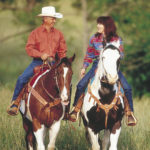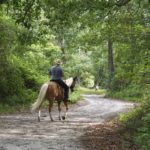Northland Cutter was enjoying the fresh air blowing through his mane and the freedom from the confinement of his stall that his morning workouts at the racetrack afforded him. With keen, kind eyes he sized-up the competitors alongside him on the northern Kentucky track that day–horses who were also enjoying their time away from the barns.

But by the end of the workout, the well-bred son of champion Macho Uno had sustained a catastrophic injury–fractured sesamoids in both front legs–and was facing a bleak future before he even made it to his first race.
Meanwhile, 100 miles down the road, something was brewing that would determine Cutter?s fate. An organization called the Kentucky Equine Humane Center (KyEHC) was poised for an intervention.
KyEHC is a model shelter for equines from across the state. No horse in need of shelter is ever turned away, regardless of breed or mix of breed. After only two years in operation, KyEHC has assisted hundreds of unwanted horses through adoption or, when necessary, humane euthanasia. They agreed to take the Florida-bred grey gelding off the track to see if there was anything they could do for him.
Cutter arrived safely at the 72-acre farm near Lexington, but after a thorough veterinary assessment it was reluctantly agreed that the best they could offer him was a humane end. With dozens of other rescued horses already under roof, the resources were simply not available for the non-profit organization to invest in a horse who would require a minimum of six months of rehabilitation, with no guarantee that he would ever be adoptable.
However, at the same time a team from the Kentucky Horse Park was visiting KyEHC to discuss providing a foster home at the park for some pregnant Thoroughbred mares who could take part in one of the park?s tourist attractions, the Mare and Foal Show. Kathy Hopkins, Equine Director for the park, happened to walk past Cutter?s stall and was immediately drawn by the horse’s extraordinary good looks and kind disposition.
Then she learned about Cutter?s extensive injuries and looming departure from this world.
An hour later, Kathy and KyEHC Executive Director Lori Neagle, along with the team from the Kentucky Horse Park, had formed a partnership and developed a plan for the park to take not only the pregnant mares they had originally come to see, but also some unbroken horses–as well as Cutter–into a program at the park called the Professional Horseman?s Course.
The partnership allows some of the KyEHC rescued horses to come to the park each year for foster care and receive rehabilitation and training. Care for the horses is provided by park staff and by students enrolled in the Professional Horseman?s Course, which started in January of 2010.
In the Professional Horseman?s Course, students have the rare opportunity to study and work with up to 40 breeds of horses at the park and gain hands-on knowledge and experience regarding handling, feeding, grooming, foal-watching, rehabilitation of injured horses, and training techniques utilized in today?s equine industry. The goal of the program is to provide information and skills necessary for the graduates to enter many facets of the horse business.
Through the partnership with KyEHC, students truly make a difference in the lives of horses like Cutter who, due to no fault of their own, have found themselves in need of new homes. The students also assist in the subsequent adoption process.
Cutter has been at the Kentucky Horse Park for several months receiving the rehabilitation he needed, and last month the veterinarian gave permission to start him under saddle for light riding. His empty stall at KyEHC was immediately occupied by another horse who needed shelter, and the students in the Professional Horseman?s Course learned invaluable skills as they tended to Cutter?s special needs.
John Nicholson, Executive Director of the park summed up the new partnership this way, ?This might be a perfect example of ?what goes around comes around.? As we step up to the plate to help horses like Cutter, the horses will, in turn, help our students to become more qualified and conscientious caretakers, who will accordingly discover ways to make their own valuable contributions to the horse industry. Everyone wins.?





